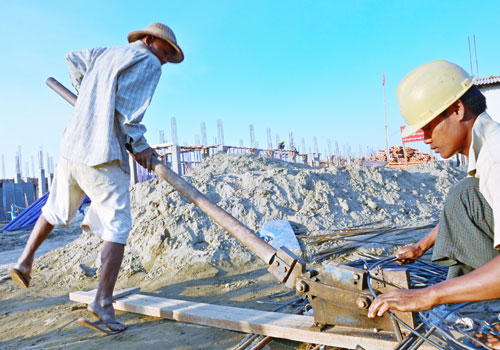 Amid estimates that Yangon’s population of 7 million-plus will move into double-digits in the next 10 to 20 years, what is being done to solve the commercial capital’s housing crisis?
Amid estimates that Yangon’s population of 7 million-plus will move into double-digits in the next 10 to 20 years, what is being done to solve the commercial capital’s housing crisis?
le, the government is also moving to finalise other new rules and regulations, he said. The regional government recently sent new building rules to YCDC for review, which concern things like parking requirements, fire resistance standards and how much space between buildings and the road must be left by developers.
“Once YCDC confirms they will announce [details of the] new regulations,” he told The Myanmar Times on September 19.
The problem is exacerbated by the slow pace of economic and social development, which keeps incomes down.
Yangon, home to 7.3 million people, according to the 2014 census, is also the epicentre for much of the country’s industry and services, and generates about 20 percent of Myanmar’s GDP.
About 25pc of its dwellings are temporary huts and shanties thrown up to house the huge influx of squatters attracted by factory work in the city’s industrial zones, according to the Department of Urban and Housing Development under the Ministry of Construction.
Up to 65pc of Yangon residents own their homes, and the other 35pc rent, according to department data. Meanwhile, the population is expected to grow each year, says U Myint Naing, the department’s assistant director.
“The population of Yangon may expand to about 10 million in the next 10 to 20 years. Getting the accommodation question right is important not just for now but for decades into the future,” he said.
Most Yangon residents – almost 60pc – earn only K300,000 a month (US$244) or less, according to department estimates from 2015. But affordable housing is in short supply: Most of the boom in accommodation construction over the past few years has been at the luxury end of the market.
U Toe Aung, assistant director of the City Planning and Land Administration Department of Yangon City Development Committee, said, “Though by World Bank standards K300,000 counts as medium income, someone earning that kind of money cannot buy a house.”
If a combination of government and private building can provide the necessary low-cost housing in the numbers required, such a solution is not yet in sight.
The main challenge of low-cost housing is the need for sufficient investment to be able to sell apartments for under K10 million, said U Myint Naing. “Most building materials have to be imported. There are no plans to build K10 million apartments under current market conditions,” he said.
If the government is unenthusiastic, private builders show even less interest.
“It could be possible to build low-cost homes on state-owned land, with the government providing water and other infrastructure, for less than K10 million per apartment. But given the limitations of the government budget, it would be very difficult to provide enough of them,” said U Myint Naing.
YCDC’s U Toe Aung said that, in any case, renting was a better option for low-income residents.
“Even civil servants don’t earn enough to buy those apartments. The solution might be to develop the rental sector,” he said, adding that however the government might find it difficult even to do that.
“Private developers are not interested, and the government will not be able to build a lot of rental accommodation. It will be a very long-term proposition,” he said.
A spokesperson for the City and Housing Development Bank, which offers loans to home-buyers, said much of the public was unfamiliar with the concept of borrowing money to fund a home purchase.
The Ministry of Construction is planning to sell more than 1000 low-cost apartments in Yangon and to build and sell 8000 apartments over the next two years, Assistant Director U Myint Naing of the Department of City and Housing Development has announced. But set against the estimated 4.6 million Yangon residents earning K300,000 a month, that will be a very small drop in a very large bucket.
Translation by San Lay and Khine Thazin Han
Quoted from mmtimes.